Overview of Tianjin Ancient Culture Street
Tianjin Ancient Culture Street is located outside the east gate of the northeast corner of Nankai District, Tianjin, and faces the west bank of the Haihe River. It is a famous commercial pedestrian street and a national 5A tourist attraction.
Since its completion and opening on New Year's Day in 1986, Ancient Culture Street has attracted countless tourists and citizens to visit, shop and experience Tianjin's traditional culture with its unique business characteristics of "Chinese flavor, Tianjin flavor, cultural flavor, ancient flavor".
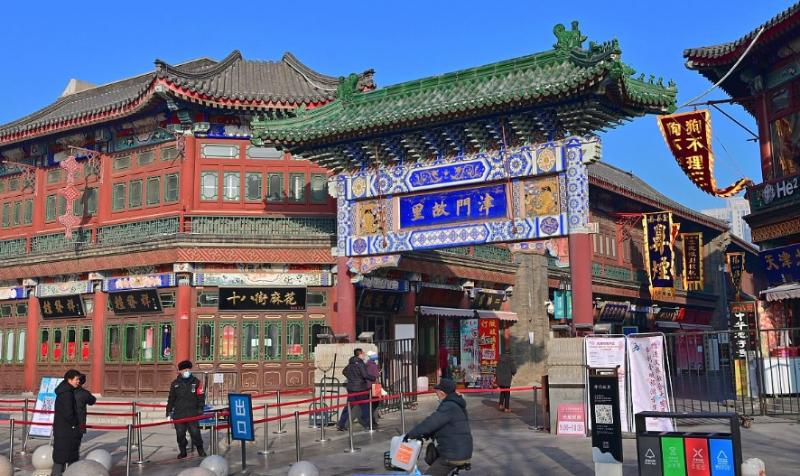
Geographic Environment of Tianjin Ancient Culture Street
Location and Overview
Tianjin Ancient Culture Street is situated outside the East Gate in the northeast corner of Nankai District, near the west bank of the Haihe River. Its prime location is close to Tianjin City's road zero point. The street is 687 meters long and 5 meters wide, serving as a commercial pedestrian street. It starts from Laotieqiao Street (Gongbei Street) in the north and extends to Shuige Street (Gongnan Street) in the south. There are archways at both the north and south ends, inscribed with "Hometown of Tianjin" and "Art Garden of Gushang," respectively. These archways are not only landmark structures but also add to the rich historical and cultural atmosphere of Ancient Culture Street.
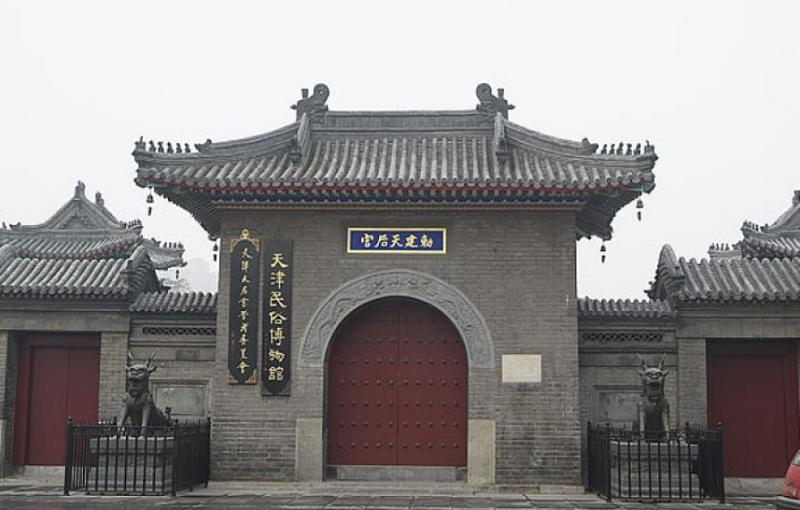
History and Legend of Tianhou Palace
Tianhou Palace is one of the core buildings on Ancient Culture Street, with a history dating back to 1326. The palace was built to worship the sea goddess Tianhou. Tianhou, also known as Mazu, was regarded as a guardian goddess of sailors in ancient times. According to legend, Tianhou, whose real name was Lin Mo, was from Fujian and often sailed to rescue people in distress, earning her deification.
During the Yuan Dynasty, a large amount of grain had to be transported north to the capital each year. This grain was first shipped to Tianjin by sea and then transported by river to the capital. To ensure safe navigation, the Yuan government revered Tianhou as the Heavenly Concubine and built Tianhou Palaces in coastal towns. Tianjin’s Tianhou Palace was established in this context, and every year on the 23rd day of the third lunar month, a grand celebration is held in honor of Tianhou’s birthday.
Architectural Style and Cultural Characteristics
The architectural style of Ancient Culture Street mainly imitates small shops from the Qing Dynasty, giving the entire street an ancient charm. The buildings along the street are mostly two-story structures with traditional gray-tiled roofs, often decorated with exquisite paintings and wood carvings under the eaves, showcasing rich historical and cultural heritage and artistic value.
Tianhou Palace is the most significant building on Ancient Culture Street, commonly referred to as "Nian Nian Palace." The square in front of Tianhou Palace and the areas to the north and south are traditional performance venues. Every year on the 23rd day of the third lunar month, a grand imperial festival is held here, named after Emperor Qianlong of the Qing Dynasty, who visited the area during his southern tours. Performances include dragon dances, lion dances, Shaolin martial arts, stilt walking, drumming, dry boat performances, folk dances, martial arts, Peking opera, Ping opera, and Bangzi opera, attracting numerous tourists and locals.
Convenient Transportation
Ancient Culture Street enjoys a superior geographic location and convenient transportation. It is close to the center of Tianjin, with multiple bus routes and metro stations nearby, making it easily accessible for visitors. Additionally, Ancient Culture Street is adjacent to the Haihe River, allowing visitors to arrive by waterway, further enhancing the convenience and enjoyment of the tour.
Surrounding Environment
The surroundings of Ancient Culture Street are beautiful, with the Haihe River providing a pleasant riverside landscape, making it an ideal place for visitors to relax. There are many historical buildings and modern facilities along the Haihe River, giving the area a blend of historical depth and modern urban vitality. Whether day or night, Ancient Culture Street and the Haihe River scenery offer rich visual enjoyment for visitors.
Historical and Cultural Background
Historical Background
Tianjin Ancient Culture Street, located in the northeast corner of Nankai District, Tianjin, is a street featuring shops that imitate Qing Dynasty small-style folk architecture. It is centered around the Yuan Dynasty relic Tianhou Palace, also known as "Nian Nian Palace," the main attraction on Ancient Culture Street. The construction of Ancient Culture Street aims to promote traditional Chinese culture and preserve and showcase the historical appearance of Tianjin.
Origin of Tianhou Palace
Tianhou Palace, the core building on Ancient Culture Street, has a history spanning several centuries. Initially called "Tianfei Palace," it was later renamed "Tianhou Palace." Tianjin's location near the Bohai Sea and its proximity to the capital made it an important water and land transportation hub since ancient times. The establishment of Tianhou Palace was closely related to the development of grain transportation in Tianjin, built to worship the sea goddess Tianhou and ensure the safety and smoothness of grain transport.
Construction and Opening
Ancient Culture Street was officially completed and opened on New Year's Day in 1986. Historically, this area was Tianjin's largest market trade and New Year's goods market. Every spring, the grand imperial festival celebrating the birthday of Tianhou is held here. During the festival, Ancient Culture Street is bustling with traditional performances such as stilt walking, dragon dances, dry boat performances, and lion dances, bringing endless joy to people.
Architectural Style
The architectural style of Ancient Culture Street mainly features small-scale ancient buildings imitating Qing Dynasty folk architecture. There are archways at both the north and south ends, inscribed with "Hometown of Tianjin" and "Art Garden of Gushang." Nearly a hundred houses along the street are small-style ancient buildings imitating Qing folk architecture, except for the archways and the opera stage in front of the palace, which are imitations of large-style Qing architecture. The rest of the buildings maintain an ancient and elegant style, making visitors feel as if they have traveled back to Tianjin a hundred years ago.
Cultural and Artistic Features
Strolling along Ancient Culture Street, you will find many shopfronts decorated with Suzhou-style paintings, a characteristic of Jiangnan garden art. These paintings are vivid and lifelike, adding splendid colors and enchanting charm to Ancient Culture Street. The decorations of the shopfronts, including brick and wood carvings, are unique, featuring a wide range of subjects filled with strong folk customs and auspicious meanings.
For example, the wood carvings in front of Shibaozhai are inspired by several dramatic scenes from "Along the River During the Qingming Festival." One scene depicts numerous boats moored along the Bian River, with seven or eight people rowing vigorously on a large boat in the river's center, vividly showcasing the busy water transportation. Another scene shows a rainbow bridge outside the east water gate on the Bian River, crowded with people, illustrating the peak part of "Along the River During the Qingming Festival."
Combination of Commerce and Culture
Ancient Culture Street not only boasts unique architectural styles but also features shop decorations, signboards, couplets, and merchandise with a rich artistic flavor. There are many old folk handicraft shops, such as antique shops, calligraphy and painting stores, stationery stores, stele rubbings, ancient books, Yangliuqing New Year paintings, Niren Zhang clay sculptures, and Tianjin kites. Visitors can admire and purchase various artworks here, enjoying the immersion in traditional culture.
Additionally, Ancient Culture Street offers specialized stores for musical instruments, artistic ceramics, and decorative items, providing visitors with a diverse shopping experience. Whether buying a favorite item or simply enjoying the view, Ancient Culture Street offers a pleasant shopping experience and rich cultural enlightenment.
Major Attractions
North and South Archways
There are archways at both the north and south ends of Ancient Culture Street, symbolizing the gateway to this historical and cultural district. These archways are decorated with "Yan Mo Shi Nian Yu" style paintings. The south archway reads "Hometown of Tianjin" (facing south) and "Sunny Snow" (facing north), while the north archway reads "Art Garden of Gushang" (facing north) and "Golden Turtle" (facing south).
The two archways, with a height of over 10 meters, feature small green glazed tiles and paintings under the eaves, inscribed with ancient couplets, making them landmarks and cultural symbols of Ancient Culture Street.
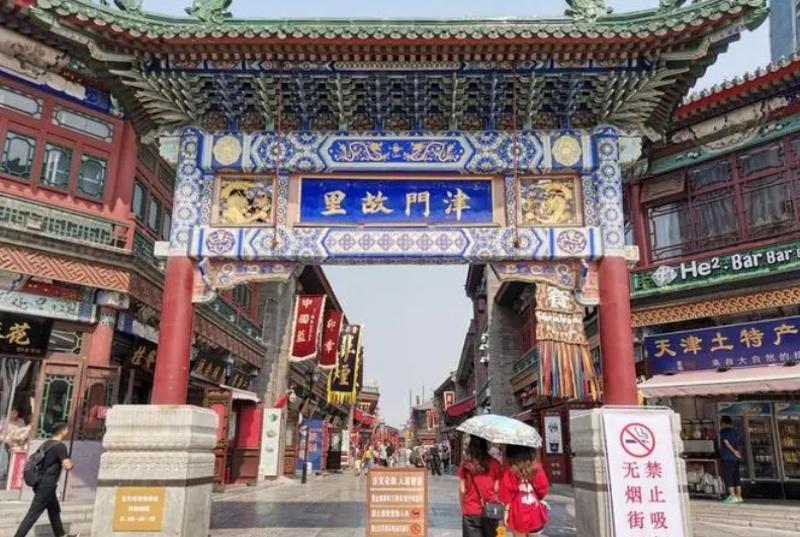
Tianhou Palace
Tianhou Palace is the core building on Ancient Culture Street, with a square in front and two 600-year-old masts. There is an opera stage near the Haihe River on the east side of the square, forming a relatively independent space.
Masts: The tall masts have stood for over 600 years. During the imperial festival and Tianhou's birthday, they are adorned with red lanterns, praying for safe voyages.
Architectural Layout: Tianhou Palace includes 14 main buildings, such as the front hall, main hall, Medicine King Hall, Taiwan Hall, Fengwei Hall, Sutra Hall, Guan Yu Hall, Yuancheng Hall, Qisheng Shrine, God of Wealth Hall, Bixia Yuanjun Hall, Lady Wang San Hall, and Liangyuan Pavilion.
Tianyan Square
Tianyan Square is located in the Dashi Hutong of Ancient Culture Street and is the site of Yan Fu's former residence. To commemorate this important figure in modern Chinese thought, Tianjin built Tianyan Square on the original site of Yan Fu's residence, featuring a bronze statue of Yan Fu and an inscription of "Tianyanlun."
Yan Fu: Yan Fu was a representative of the modern Chinese reformist movement, famous for translating Huxley's "Evolution and Ethics." He advocated self-strengthening to save the nation from peril, having a profound impact on modern Chinese history.
Ancient Street Experience
After renovation, Ancient Culture Street has retained its original architectural style and basic layout, featuring small-scale buildings from the Ming and Qing Dynasties. The one- and two-story buildings are arranged harmoniously, with the street’s natural curves, orderly shopfronts, and a strong sense of ancient, cultural, Chinese, and Tianjin flavor.
Architectural Style: Imitates small-scale buildings from the Ming and Qing Dynasties, with one- and two-story structures, moderate exterior sizes, and orderly shopfronts.
Suzhou Paintings: Shopfronts are decorated with vivid and lifelike Suzhou-style paintings.
Imitation Ancient Paintings
After the renovation, Ancient Culture Street not only improved fire and earthquake resistance but also added heating, cooling, communication, public health facilities, and parking lots. The Tianjin Real Estate Corporation adopted an open bidding process, hiring several professional design units to ensure the cultural quality and complete functionality of Ancient Culture Street.
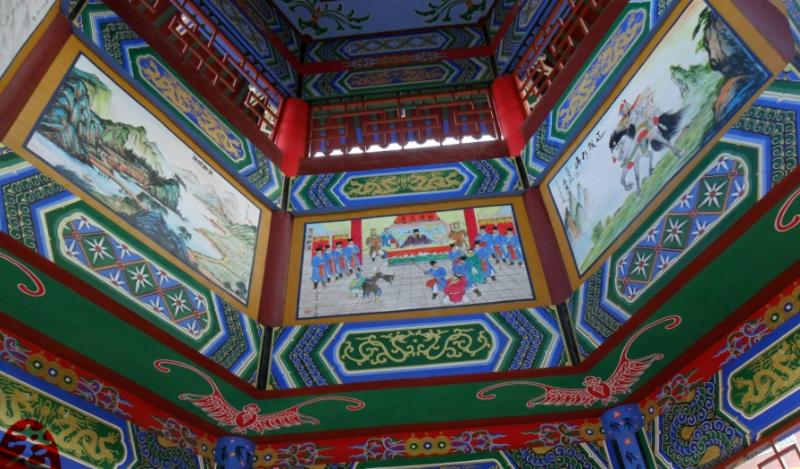
Painted Decorations: The square in front of the palace showcases paintings depicting Tianjin's folk customs during the late Qing and early Republic periods. The imitation ancient paintings on the street unfold from south to north, based on China's four great classics: "Romance of the Three Kingdoms," "Water Margin," "Journey to the West," and "Dream of the Red Chamber," as well as historical stories, ancient legends, and famous dramas, making visitors feel as if they are immersed in the river of history.
The imitation ancient paintings, brick and wood carvings, and Suzhou-style paintings on Ancient Culture Street reflect Tianjin's rich historical and cultural connotations. The architectural style of the street, shop decorations, signboards, and couplets all exude an artistic atmosphere, making it a delightful cultural tourism destination for visitors.
Tianjin Ancient Culture Street Business Characteristics
Qiaoxiang Pavilion
In 1989, Qiaoxiang Pavilion, a shop specializing in cloisonné, Suzhou embroidery, and inner-painted crystal, was established in Tianjin Ancient Culture Street. Since its inception, Qiaoxiang Pavilion has continuously expanded its business scope and sales channels, gradually extending its operations to Germany (e.g., Bremen, Berlin, Lübeck), Japan (Osaka), and Malaysia (Klang, Kuala Lumpur). Despite the increasing number of similar shops, Qiaoxiang Pavilion always stands in the customer's position, attracting domestic and foreign customers with new products and high quality, earning a good reputation.
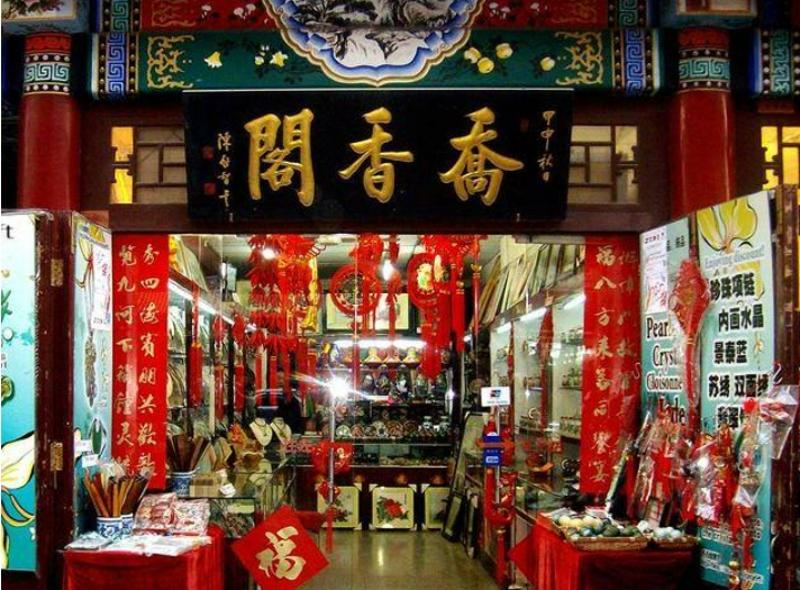
- Business Scope: Initially focused on cloisonné, Suzhou embroidery, and inner-painted crystal, it gradually expanded to include pearls, jadeite, craft umbrellas, craft swords, traditional Chinese clothing, and over a dozen other products.
- Handcrafted Jewelry: The owner's unique handcrafted necklaces made of crystal, pearls, and tourmaline have attracted considerable attention and love from customers.
- Internationalization: Qiaoxiang Pavilion aims to bring Chinese products with national characteristics to the world during the deepening wave of globalization, enhancing the country's prestige.
Qiaoxiang Pavilion's success lies not only in its diverse range of products and quality assurance but also in its international business strategy, securing a place for Tianjin Ancient Culture Street's traditional crafts in the international market.
Jinmen Time-Honored Brands
Ancient Culture Street not only features innovative shops like Qiaoxiang Pavilion but also many time-honored Jinmen shops known nationwide for their long history and unique products.
- Guoren Zhang: Famous for its traditional nut candies, which are crispy, sweet, but not greasy, and loved by customers.
- Pitang Zhang: Specializes in making pitang, a chewy and uniquely flavored candy with a strong local character.
- Bengdou Zhang: Specializes in various roasted bean products, with exquisite roasting techniques, crispy texture, and a wide variety.
- Niren Zhang: Known for its clay sculptures, with lifelike works rich in folk art.
These time-honored shops are not only an essential part of Tianjin Ancient Culture Street but also important windows showcasing Tianjin's traditional culture. Each shop has a unique history and heritage, adding historical depth and cultural richness to Ancient Culture Street.
Cultural Heritage and Innovation
As an important cultural landmark in Tianjin, Ancient Culture Street not only preserves a rich historical and cultural heritage but also promotes these traditional cultures to broader markets through innovative operations and international strategies. Whether it's new shops like Qiaoxiang Pavilion that actively explore international markets or time-honored shops like Guoren Zhang and Pitang Zhang with long histories, they all work together to inherit and promote the unique culture of Tianjin Ancient Culture Street.
Every item and shop on Ancient Culture Street carries profound cultural connotations and historical accumulation. Strolling along the street, visitors can not only feel the historical charm of Tianjin but also experience the allure of traditional culture firsthand. In the future, Tianjin Ancient Culture Street will continue to adhere to the dual emphasis on cultural heritage and innovative development, striving to create a more vibrant and attractive cultural tourism destination.
Folk Customs
History and Architectural Style
Tianjin Ancient Culture Street was completed and opened on New Year's Day in 1986, with an overall architectural style imitating Qing Dynasty folk style. As one of Tianjin's cultural symbols, Ancient Culture Street showcases a rich historical look and cultural heritage. The center of the street houses Tianhou Palace (Mazu Temple), an important cultural and religious landmark of Ancient Culture Street.
Shops and Business Characteristics
Ancient Culture Street features nearly a hundred shops, each offering unique products that showcase the rich local culture and traditional crafts of Tianjin:
- Yangliuqing Painting Society: Specializes in Yangliuqing New Year paintings, known for their bright colors and profound meanings.
- Niren Zhang Clay Sculpture Craft Store: Specializes in clay sculptures, with lifelike works rich in folk art.
- Four Treasures Hall and Chun Zai Hall: Specialize in the four treasures of the study and famous calligraphy and paintings, providing a rich selection for art enthusiasts.
- Cuiwen Zhai Store: Specializes in cultural relics and antiques, gathering various precious historical artifacts and antiques.
- Other Craft Shops: Offer over ten thousand high-quality handicrafts, including cloisonné, double-sided embroidery, ivory and jade carvings, artistic ceramics, musical instruments, and gold and silver jewelry, attracting many domestic and foreign tourists with their quality and reputation.
Ancient Culture Street consistently adheres to the business characteristics of "Chinese flavor, Tianjin flavor, cultural flavor, and ancient flavor." Over 12 years of diligent operation, the total turnover has reached 690 million yuan, creating 58 million yuan in profit and tax, and receiving 12 million domestic and foreign visitors. Party and state leaders have also visited many times for inspection.
Famous Evaluation and Visitor Reception
During his visit to Ancient Culture Street, Comrade Deng Xiaoping remarked, "Ancient Culture Street is very distinctive and certainly attractive to foreigners." This evaluation not only affirmed the cultural value of Ancient Culture Street but also positively promoted the attraction of more international tourists. Ancient Culture Street welcomes tourists from all over the world with its rich folk customs and enthusiastic, attentive service and actively participates in commodity exhibitions and cultural exchange activities worldwide.
"Imperial Fair" Traditional Activity
The "Imperial Fair" of Tianjin Ancient Culture Street is a renowned traditional activity, originally known as the "Niaonai Fair." It is said that the 23rd day of the third lunar month is the birthday of the sea goddess Mazu. Since the Kangxi period of the Qing Dynasty, fairs have been held four days before Mazu's birthday. During this time, folk performance groups would perform various skills along the street, creating a lively scene.
After the restoration of Ancient Culture Street, the "Imperial Fair" was revived every year on the 23rd day of the third lunar month. On this day, the streets are filled with dragon lanterns, stilt walkers, dry boats, yangge dances, drum performances, middle flags, lion dances, and martial arts performances, attracting many citizens and tourists, becoming an important event that enriches the cultural life of citizens.
Tianjin Local Characteristics
Ancient Culture Street is not only a gathering place for handicrafts but also showcases the cultural treasures of Tianjin:
- Yangliuqing New Year Paintings: These brightly colored paintings reflect the rich folk culture and historical traditions.
- Niren Zhang Clay Sculptures: Known for their exquisite craftsmanship and realistic shapes, representing Tianjin folk art.
- Wei Kites: Tianjin's traditional kites are famous nationwide for their unique designs and superb craftsmanship.
Architectural Style and Decoration
The architectural style of Ancient Culture Street imitates Qing Dynasty folk buildings, showcasing a rich historical and cultural atmosphere. Each side of the street features a painted archway with the inscriptions "Homeland of Tianjin" and "Art Garden of Gushang," highlighting Tianjin's unique regional culture. Nearly a hundred shops within the street are Qing-style buildings, with windows and doors adorned with exquisite painted patterns, mainly depicting history, mythology, figures, flowers, and birds in various forms, including openwork carving, relief, and round carving.
Business Characteristics and Shop Types
Ancient Culture Street primarily sells cultural items such as the four treasures of the study, famous calligraphy and paintings, cultural relics, antiques, and handicrafts. Representative shops include:
- Yangliuqing Painting Society: Specializes in Yangliuqing New Year paintings, attracting many tourists with their unique style and colors.
- Niren Zhang Clay Sculpture Craft Store: Specializes in clay sculptures, known for their vivid and lifelike appearance.
- Old-Brand Snack Shops: Such as Stone Door Threshold Restaurant, offering traditional Tianjin snacks for visitors to enjoy.
Travel Guide
Tour Routes
Duration: 3 hours
Suitable for: Friends
Transportation: Bus
Attractions:
- Homeland of Tianjin Archway
- Tianhou Palace
- Folk Culture Museum
- Antique City
- Commercial Plaza
- Official Bank
- Art Garden of Gushang Archway
- Yuhuang Pavilion
- Tongqing Lane
- Culture Town
- Theater
Transportation Guide
By Car:
From Outside the City (Beijing - Tianjin Ancient Culture Street Tourist Area):
Route: S30 Beijing-Tianjin Expressway - Exit at Shuangjie - Beijing-Tianjin Expressway - Jingtian Road - Tiantai Road - Huangwei Road - Wuma Road - Haihe East Road - Shizilin Street - Zhang Zizhong Road - Main Entrance of the Scenic Area
Time: 1 hour 45 minutes
Within the City:
Route: Huanghe Road - Nanma Road - Chengxiang East Road - Dongma Road - Tongbei Road - Zhang Zizhong Road - Main Entrance of the Scenic Area
Time: 11 minutes
By Public Transport:
Bus:
- Routes: 15, 12, 856, 907, 861, 675, 681, 863, 903, 907, 469
- Destination: Dongma Road Station
- Fare: 2 yuan per person
- Frequency: Every 10 minutes
- First/Last Bus Time: 06:00-21:00
Taxi:
- Starting fare: 11 yuan
Free Policy
In February 2020, to honor the medical workers fighting on the front line of the epidemic, from the end of the epidemic until December 31, 2020, all medical workers nationwide are entitled to free admission. Medical workers can enjoy the free admission policy by presenting their ID card and valid medical practitioner certificate (doctor or nurse license). The scenic area will prominently display relevant information at the entrance and ticket window.